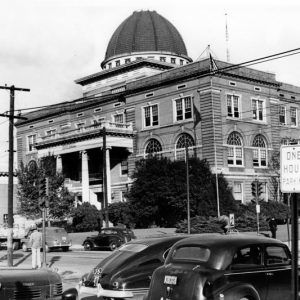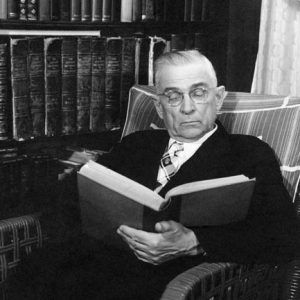calsfoundation@cals.org
Little Rock City Hall
Little Rock City Hall is located on the northwestern corner of West Markham and Broadway in Little Rock (Pulaski County). Designed by noted architect Charles L. Thompson, it has been the seat of government for the state’s largest municipality since 1908. Interestingly, the Arkansas Gazette heavily opposed the building’s construction, even suing the city to stop it.
The old Little Rock City Hall, constructed in 1867, was located at 120–122 Markham Street, the current location of the Statehouse Convention Center. Twenty years after its construction, the old city hall was in ruins, and calls for a new city hall were voiced. Arkansas Gazette editors wrote at the time, “It is to be noticed too, that our worthy council have not been forgetful of the dignity and position to which our city has attained; and determined to provide suitable public buildings.” Mayor Warren Lenon vehemently expressed hope for construction of a new municipal building when he was elected in 1903.
On December 28, 1905, the Little Rock City Council approved $150,000 to build the current Little Rock City Hall. This infuriated the editors of the Arkansas Gazette, however, who felt that monies for a new city hall would be better spent on sanitation improvements, and that city leaders had spent well over the budgeted amount. The Gazette editors, led by J. N. Heiskell, took Mayor Lenon and the city council to court to settle the issue; the litigation lasted two years. During the 1906 trial, Lenon was asked the exact contract amount to date. He stated that it was $237,000, which included an auditorium. Judge J. C. Hart demanded a price without the auditorium addition. The amount was $147,000. Hart allowed the construction of the new building.
Work on the new city hall started on November 4, 1906, and a grand-opening celebration for the three-story building featuring decorative stone was held on April 15, 1908. Children ran up and down the marble staircase, which was one of the few original adornments of the neoclassical design. From 1929 to 1942, the third floor of the building was home to the Museum of Natural Science and Antiquities, precursor to the Museum of Discovery. Thompson’s original design included a dome, but a popular vote in 1955 decided that it should be torn down; it was demolished in 1956.
In the 1960s, the exterior was significantly changed when many of the outside walls were cemented in order for a new air-conditioner unit to be installed, along with other modernizations. A connecting fire station is located just to the west of the main structure. The building was added to the National Register of Historic Places on October 18, 1979.
For additional information:
Hart, Josh. “Luxury or Necessity: An Examination of the Construction Process of Little Rock City Hall.” MA thesis, University of Arkansas at Little Rock, 2013.
“Little Rock City Hall.” National Register of Historic Places nomination form. On file at Arkansas Historic Preservation Program, Little Rock, Arkansas. Online at http://www.arkansaspreservation.com/National-Register-Listings/PDF/PU3239.nr.pdf (accessed September 16, 2021).
Josh Hart
Little Rock, Arkansas
 Early Twentieth Century, 1901 through 1940
Early Twentieth Century, 1901 through 1940 Historic Preservation
Historic Preservation Politics and Government
Politics and Government Little Rock City Hall
Little Rock City Hall  Charles Thompson
Charles Thompson 



Comments
No comments on this entry yet.